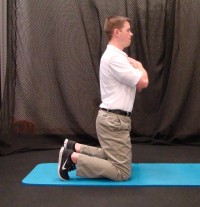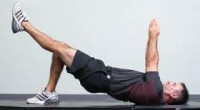A healthy spine helps contribute to the golf swing in a number of ways. Multiple segments create a chain along the length of the spine allow for both stability and mobility. The lower lumbar and upper cervical spine by definition should be stable while the spinal segments of the thoracic spine should create a mobile middle. When this relationship is reversed or altered, the chain in compromised and the movement pattern becomes dysfunctional. Let us first look at the lower lumbar spine in our quest for complete spine health.
In order to create this healthy a relationship in the lumbar spine, we must address what its primary function. Do to the large weight bearing properties of the lumbar spine, it is wise to add assistance of the surrounding muscles to help in this heavy job. This ultimately comes down to pelvic control creating a sturdy base for the spine segments to sit upon. A few drills can be done to both test and strengthen the pelvis.
Begin with a move called the Pelvic Tilt Test derived from the TPI movement assessment. Kneeling on a pad or pillow, tilt the pelvis under the body as far as you can then tilt the other direction by arching the back. This move should be done with only the lower abdominals and glutes. There should be no upper body movement during the exercise. If movement occurs in the upper body, there is the potential for upper body stability issues. The end goal of this drill is to perform it in golf posture. (These will be address in a future post.)

The other way to check pelvic control is by a bridge with leg extension. Lying on your back with your knees bent, push your hips to the ceiling. Once the hips are elevated, kick one leg out holding that position for 10 seconds. Repeat the same on the opposite side. This again tests glute and abdominal control along with the endurance of these structures when put under stress. These two positions can be trained and tested in the same fashion to see how you are progressing. Functional exercise progressions are sometimes needed to make these movements more efficient. See here.

Try them out to see where you stand. Be sure to check back to see how we test and train the next segment: the thoracic spine.
If you try these exercises and you find them to be too challenging or uncomfortable, do not continue, until you have consulted with your physician. All exercises for golf should be customized to your needs after a proper evaluation.
Come In and See Us
Want to take your golf to the next level? Our FitGolf® Trainers are experts at working one-on-one with you to tailor a training program to meet the specific needs of your body and help you achieve the results you are hoping to see in your golf.
Want More Resources?
Looking for more exercise resources, blog posts or monthly golf-specific exercise content sent straight to your inbox?

[…] looking at the lumbar and thoracic vertebrae. You can read those previous posts by checking out Part 1 and Part 2. This week we look to the cervical spine for its function and health along with how it […]